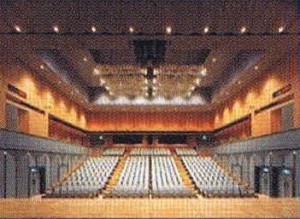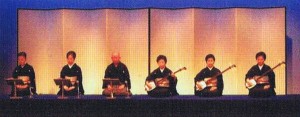Reiki Party – Spirit of Japan
The final event of the Gendai Reiki Network International Conference in Kyoto was entitled Yui, which means Spirit of Japan. The event was held in a very large hall, it was open to the public, and was an amazingly rich experience. I will write separately about some of the individual presentations.

Gendai Reiki Network International venue – The Alti, Kyoto
This Reiki party began with a truly atmospheric example of the Spirit of Japan – a Nagauta performance by Kiyohachi Okayasu, who is the seventh generation of his family to become a Nagauta Master.
Nagauta, literally meaning “long song”, is the traditional Japanese music of the kabuki theatre. Performances are often accompanied on the shamisen, which is a plucked lute with three strings. The shamisen is plucked with a large plectrum called a bachi (the bachi looks like a wallpaper scraper). The neck of the shamisen is fretless, and is slimmer than that of a guitar or banjo; the body resembles a drum, having a hollow body that is taut front and back with skin. The sound of a shamisen is similar in some respects to that of a banjo. Nagauta performers generally play the shamisen and sing simultaneously.
The play performed for us was Kanjincho (The Subscription List), which is a Japanese kabuki play by Namiki Gohei III, based on the Noh play Ataka. It is one of the most popular plays in the modern kabuki repertory. For those of you who enjoy World Films, Akira Kurosawa’s film The Men who Tread on the Tiger’s Tail, is partly based on Kanjincho.
Taking place in the 12th century, the play begins with a local noble called Togashi Saemon, who is charged with defending a particular gate along the road. He warns his men to be vigilant, for Minamoto no Yoshitsune, the great warrior of the Minamoto clan, is said to be travelling the road, disguised as a porter.
Yoshitsune and Bendei enter and begin to explain to Togashi that they are simple priests journeying around the northern provinces, seeking donations for the Todai-ji in Nara. Togashi thus asks that they prove themselves to be priests and asks for a kanjincho, a subscription list of those who have donated already. Benkei, having been a mountain ascetic, is educated in traditional Buddhist teachings and has little trouble as passing as a priest. But he does not have a kanjincho, so in a particularly famous moment in kabuki, he pulls out a blank scroll and begins reading from it as if it were a real subscription list.
This performance was arranged particularly for us by the Chisa Fujita, Chairman of the Gendai Reiki Network. Three of the performers are members of her family; her father, mother and sister. The Nagauta is a path of life-long learning, and is normally passed down through the generations of a family.

Nagauta performance at the Gendai Reiki International Conference 2012 in Kyoto
It was a tremendous treat for us to experience this traditional Japanese music. Every haunting cadence was sung and played with such precision, skill and power. There was no conductor, and yet the sense of timing was incredible, every note in perfect unity. Truly beautiful.
If you would like to hear Master Kiyohachi Okayasu sing and perform, follow the link: http://www.youtube.com/watch?v=jJ1W_0NM4yI
Gendai Reiki Network International Conference Echoes of the Earth
Comments are currently closed.